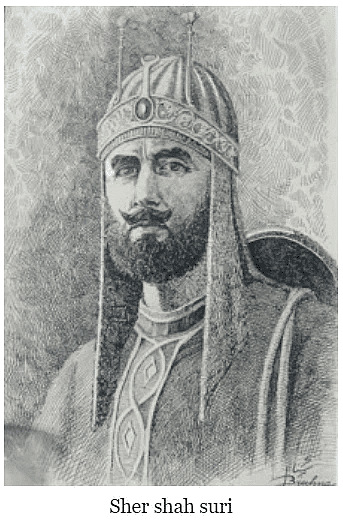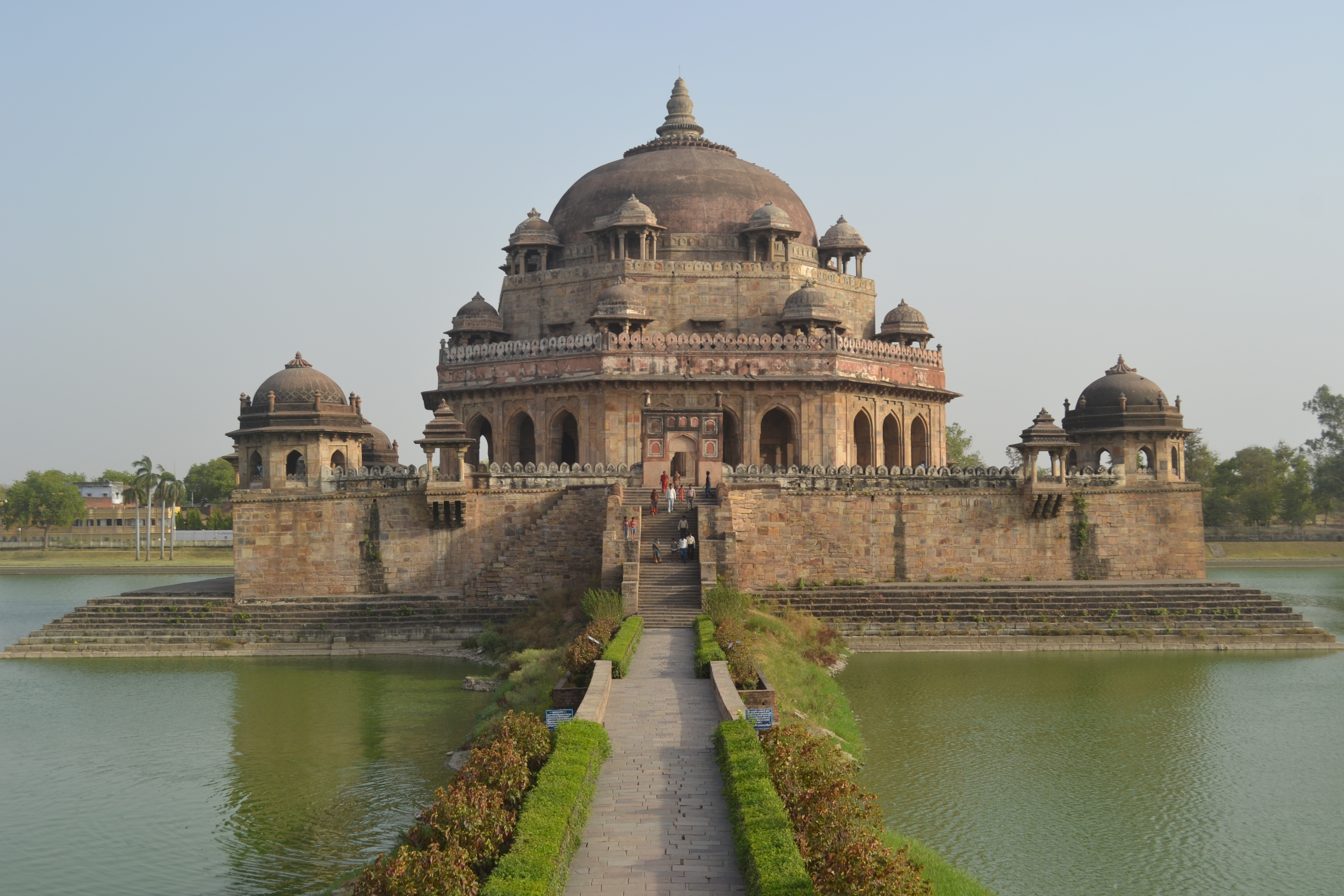The Sur Empire | History for UPSC CSE PDF Download
Sher Shah, an Afghan King, was the founder of the Sur dynasty in India who seized control of the Mughal Empire in 1540. Sher Shah Suri was born in Jaunpur, the son of a minor Afghan Jagirdar. His sponsor bestowed the title ‘Sher Khan’ on him in exchange for killing a tiger. He joined Babur’s army and learned Mughal military techniques. He overthrew Humayun and ascended to power.
The Sur Empire
- 16th Century Afghan-Mughal Contest:
- In the early 16th century, there was a power struggle between the Afghans and the Mughals in the Indian subcontinent.
- Sher Shah Suri's Rise to Power:
- After defeating Humayun, Sher Shah Suri, an Afghan ruler of Pashtun origin, emerged as a powerful leader.
- He established the Sur Empire.
- Sur Empire's Strength:
- The Sur Empire's strength lay in Sher Shah Suri's administrative capacity and reforms, focused on benefiting the people.
- The empire had well-thought-out governmental systems and policies, along with impressive architectural achievements.
- Origin of the Sur Empire:
- The Afghan chiefs, still powerful after Ibrahim Lodi's defeat by Babur in 1526, gathered under Sher Shah Suri to resist foreign rule.
- This led to the establishment of the Sur Empire, ruling from 1540 to 1556, with Delhi as its capital.
- Territorial Control and Impact on Mughals:
- The Sur Dynasty controlled a vast territory from eastern Afghanistan to Bangladesh, disrupting the Mughal Empire under Humayun.
- The Sur Empire ruled for about 17 years and implemented administrative reforms, fostered economic growth, and maintained a positive relationship with the public.
- End of Sur Empire:
- The Sur Empire's rule ended when the Mughal Empire was reinstated.
- The Surs belonged to the sub-groups of Ghilzais.
In summary, Sher Shah Suri's victory over Humayun led to the establishment of the Sur Empire, which played a significant role in the 16th-century power dynamics in the Indian subcontinent. The empire's reign brought about administrative reforms, economic growth, and positive public relations, ultimately influencing the course of the Mughal Empire.
Military Achievements of Sher Shah Suri
- Sher Shah Suri diplomatically surrenders after an encounter at the Fort of Chunar.
- Sher Shah emerges victorious in the Battle of Chausa against Humayun.
- Sher Shah decisively defeats Humayun in the Battle of Kannauj, becoming the ruler of Delhi.
- Victory at Kannauj ends Mughal dynasty rule for 15 years.
- Sher Shah defeats the combined forces of Lohani chiefs and Mohamud Shah in the Battle at Surajgarh.
- Sher Shah invades Bengal multiple times, capturing Gaur, the capital, and forcing Mohammad Shah to seek refuge with Humayun.
- Sher Shah conquers Punjab from Kamran, Humayun's brother.
- Sher Shah suppresses the turbulent Khokhars in the northern region of the Indus and Jhelum rivers.
- Sher Shah attacks and annexes Malwa due to the ruler's non-cooperation during his struggle with Humayun.
- Sher Shah besieges Raisin, a Rajput principality, and does not honor the agreement after the surrender.
- Sher Shah conquers and annexes Multan and Sind into his empire.
- Sher Shah manipulates letters and causes dissensions in the army of Maldev, bringing Marwar under his control.
- Sher Shah wins the conquest of Kalinjar but loses his life due to a grievous injury from a blast.
Central Administration
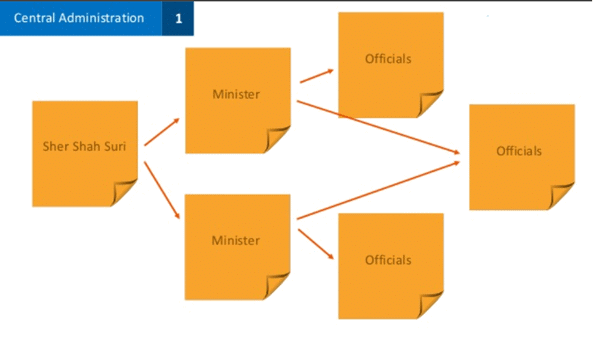
- Tarikh-i-Sher Shahi (History of Sher Shah): Authored by Abbas Khan Sarwani, this historical account provides detailed citations about Sher Shah's administration.
- Administrative Division:
- Sher Shah divided the empire into provinces but retained central authority for administration.
- He personally supervised each administrative branch, holding control over policy, civil, and military command.
- Centralized Decision-Making:
- Sher Shah exercised centralized power for the benefit of the people.
- Ministers had no authority to initiate policy changes; they managed routine daily administration.
- Appointment of Ministers:
- Similar to the Sultanate period, Sher Shah appointed four important ministers:
- (a) Diwan-i-Wazarat: Financial Department
- (b) Diwan-i-Ariz: Military Department
- (c) Diwan-i-Risalat: Department for royal orders
- (d) Diwan-i-Insha: Department for religious matters, foreign affairs, and judiciary
- Similar to the Sultanate period, Sher Shah appointed four important ministers:
- Law and Order Restoration:
- Sher Shah re-established law and order across his empire.
- Severe punishments were imposed for criminals, robbers, and Zamindars disobeying his government's authority.
Provincial Administration

- Empire Division:
- The empire was divided into 47 separate units known as Sarkars.
- Sarkars were further subdivided into Parganas.
- Officers and Responsibilities:
- Munsifs: Responsible for revenue collection.
- Amirs: Adjudicated civil cases.
- Qazis or Mir-i-adals: Handled criminal cases.
- Muqqadams: Tasked with chasing and arresting culprits.
- Pargana Administrative Structure: Each Pargana had its individual law-keeper (Ami), treasurer, and account keepers.
- Sarkar Administrative Units: Higher administrative units (Sarkar) had officers like Shiqdar-I-Shiqdaran and a Munsif-I-Munsifan overseeing Pargana officers.
- Rotation of Officers: Officers were rotated every 2-3 years across the Empire to ensure accountability and performance checks.
- Infrastructure Development:
- Important places in the kingdom were connected by excellent roads.
- The longest road, Sadak-e-Azam or "Badshahi Sadak" (later renamed as "Grand Trunk Road" by the British), facilitated military and trade movement.
- This road still exists today.
In summary, Sher Shah Suri's administrative structure involved division into Sarkars and Parganas, with officers responsible for revenue, civil and criminal cases, and law enforcement. The rotation of officers and the development of a vast road network were key features of his governance.
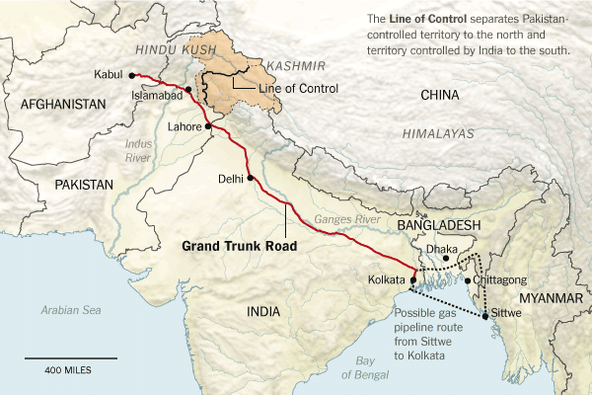 Map showing G.T. Road
Map showing G.T. Road
Local Administration
- Sher Shah delegated responsibility to local people for improving law and order.
- Appointed two persons with equal rank at Paragana and Sarkar levels to divide supervisory functions and ensure power stability.
- At the local level, village panchayats and Zamindars settled disputes and punished the guilty, reporting to the qazi in each state.
- Sher Shah restored a comprehensive road network connecting Sonargaon in Bangladesh to the Indus in the west, linking key regions like Lahore, Multan, Agra, Jodhpur, Chittor, and ports in Gujarat.
- Sarais or inns were built every eight kilometers along roads for travelers' convenience, maintained by the government from village revenues.
- Sarais served as centers for post (dak chowki), aiding information flow and keeping Sher Shah informed about activities in the Empire.
Revenue Administration
- The person in charge of revenue and finance was called the Diwan-i-Wazarat or Wazir, overseeing administration and having supervisory power over other ministers.
- Sher Shah personally paid attention to the kingdom's income and expenses, inquiring about finances and dues from the Parganas.
- Land was classified into three categories for calculating revenue, considering yield and land measurement.
- Schedules of rates were established to fix land revenue in terms of cash. Peasants received 'Pattas,' and 'Qabuliyats' were collected from them.
- Sher Shah set up a famine relief fund, funded by collecting two and a half seers per bigha from peasants.
- Standardization of gold, silver, and copper coins was introduced, along with standard weights and measures.
- Toll collection occurred twice: at the country entry and during sales transactions.
Military Administration
- The empire had a large standing army consisting of cavalry, infantry, elephants, and artillery.
- Soldiers were recruited daily, and tribal levies were used for their recruitment.
- A system of Dagh, or branding, was implemented for horses to prevent substitution with inferior ones.
- A descriptive roll of soldiers, known as huliya, was maintained to ensure the quality and identity of each soldier.
- Sher Shah focused on keeping his army efficient and well-organized to maintain its strength and effectiveness.
Religion
- Sher Shah Suri was the first Muslim ruler to recognize that India was home to both Hindus and Muslims, making efforts to reconcile the two communities.
- He extended equal treatment to all sections of his subjects, irrespective of their religious faith.
- Responsible officials, both civil and military, were recruited from among Hindus, showcasing a policy of inclusivity.
- Administered justice with strict impartiality, maintaining effective vigilance on the conduct of judicial officers.
- Despite these efforts, Sher Shah did not initiate any new liberal policies. The imposition of Jizya continued for Hindus, and his nobility was predominantly drawn from the Afghans.
Economy
- Sher Shah Suri introduced a reformed system of currency, striking fine coins of gold, silver, and copper with a uniform standard, replacing the debased coins of mixed metals.
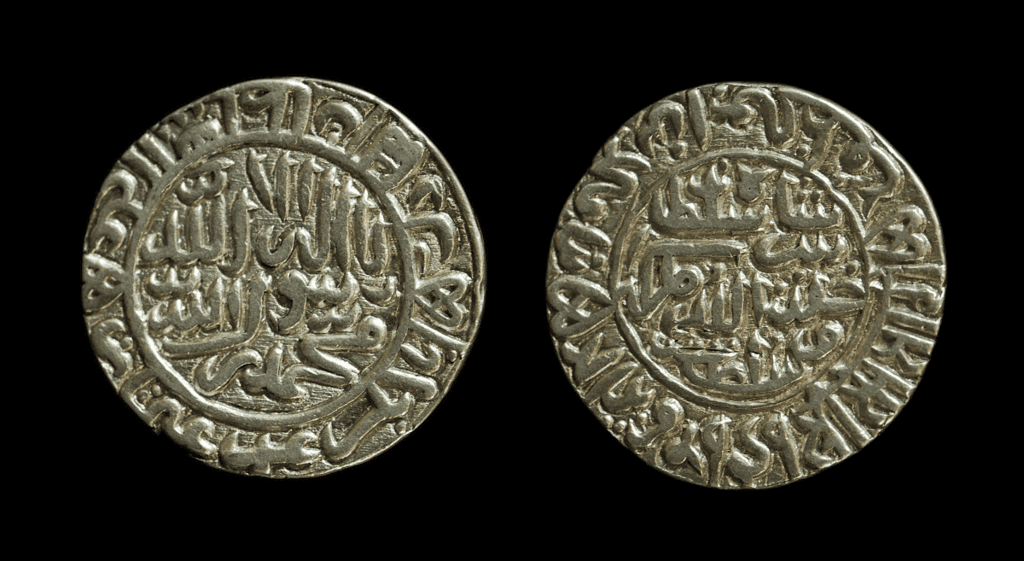
- His silver coin, known as Rupiya, and copper coin, known as Daam, became standard forms of currency, with the silver rupee remaining a standard coin for centuries after his rule.
- Credited with the introduction of custom duty to regulate trade and commerce.
- Significantly improved means of communication, restoring the famous Grand Trunk Road from Bengal to Punjab.
- Planted trees and established resting places (Sarai) along roads to facilitate troop movement and boost trade and commerce.
- Extended the Grand Trunk Road from Chittagong in Bengal to Kabul in Afghanistan, covering a vast stretch of the Indian subcontinent.
- Improved communications by laying four important highways: Sonargaon to Sind, Agra to Burhampur, Jodhpur to Chittor, and Lahore to Multan.
- Linked places like Chittor to the seaports of Gujarat, enhancing trade routes.
- Ensured law and order with severe penalties for harming traders, directing governors to treat merchants and travelers well.
- Introduced a system of horse-posts or mail service, carried by horses, contributing to efficient communication.
- Demonstrated concern for the welfare of the peasantry, reflecting a comprehensive approach to governance.
Sur Architecture
- Rohtas Fort: A significant monument recognized as a UNESCO World Heritage Site in Pakistan.
- Structures in Rohtasgarh Fort in Bihar: Various constructions commissioned by Sher Shah within the Rohtasgarh Fort in Bihar.
- Sher Shah Suri Masjid in Patna: A mosque built in Patna in honor of Sher Shah's reign, known as Sher Shah Suri Masjid.
- Bhera City in Pakistan (1545 AD): Construction of a new city, Bhera, in Pakistan in 1545 AD, featuring the "Grand Sher Shah Suri Masjid."
- Qila-i-Kuhna Mosque in Purana Quila, Delhi (1541 AD): Construction of a mosque in Purana Quila, Delhi, known as Qila-i-Kuhna Mosque, built in 1541 AD.
- Humayun Citadel and Sher Mandal (1533 AD): Initiation of the construction of the Humayun Citadel in 1533 AD. Extension included the building of Sher Mandal, an octagonal structure within the Purana Qila complex, later used as a library by Humayun.
- Sher Shah Suri, the Lion King Administrator: Acknowledged as Sher Khan, Sher Shah Suri is recognized as the Lion King administrator of medieval India. His administration combined old institutions with a new spirit to serve the interests of the people.
Reasons for Decline
- The last campaign of Sher Shah Suri was against Kalinjar, where he was injured during an accidental gunpowder blast and died.
- Sher Shah's state system was highly centered around his personality, being extremely top-heavy. The level of institutionalization of administration was low, leading to the collapse of the Sur Empire within 10 years of Sher Shah's death.
- Succeeded by his second son, Islam Shah, who ruled until 1553. Islam Shah faced challenges with rebellions from his brothers and tribal feuds among the Afghans.
- Islam Shah, though a capable ruler and general, died at a young age, leading to a civil war among his successors.
- Sher Shah's successors were incompetent and unfit for the reconstruction work he initiated. Instead of securing support from all sections of society, they created dissensions and group rivalries, lacking national solidarity among the Afghans.
- Rivalries and jealousies among Sher Shah's successors ruined the Afghans.
- The successors ignored the well-being of the peasantry, with no proper collection of revenues. The principles set by Sher Shah were forgotten, and justice for the people was neglected.
- This situation provided Humayun with the opportunity to recover his empire in India. In two hotly contested battles in 1555, Humayun defeated the Afghans and reclaimed Delhi and Agra.
Death and Succession
- Sher Shah is believed to have died from a gun powder explosion during the siege of Kalinjar Fort on 22 May 1545, while fighting against the Chandel Rajputs.
- His death has also been claimed to have been caused by a fire in his store room. Sher Shah Suri was succeeded by his son, Jalal Khan who took the title of Islam Shah Suri.
- His mausoleum, the Sher Shah Suri tomb (122 ft high) stands in the middle of an artificial lake at Sasaram, a town that stands on the Grand Trunk Road.
Important Points
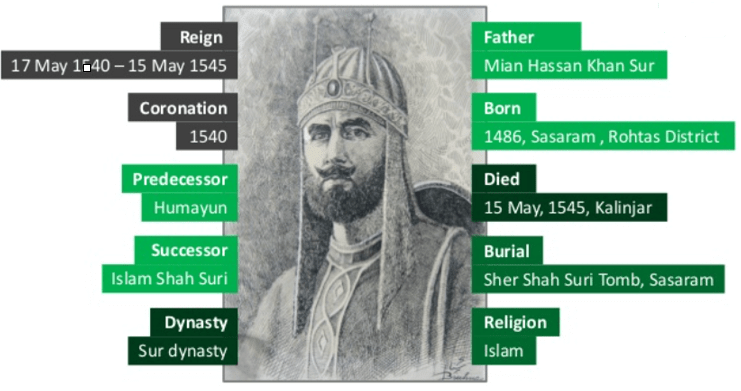
- Sher Shah Suri conquered Bundelkhand, Malwa, Multan, Punjab, and Sind, covering the entire North India except Assam, Gujarat, Kashmir, and Nepal.
- Despite a short rule of 5 years, Sher Shah organized an excellent administrative system, aided by four key ministers overseeing Revenue and Finance, Army, Foreign Affairs, and Communications.
- The empire was divided into forty-seven Sarkars, further subdivided into Parganas, each overseen by officers like Shiqdar (Military Officer), Amin (Land Revenue), Fotedar (Treasurer), Karkuns (Accountants), and Iqtas (various administrative units).
- Land survey was well-organized, classifying cultivable lands into good, middle, and bad. The state's share was one-third of the average production, paid in cash or crop.
- Sher Shah introduced new silver coins called "Dam," in circulation until 1835.
- Competent restructuring of the police system, borrowing ideas like branding of horses from Alauddin Khalji, leading to a reduction in crime during his regime.
- Developed communications by laying four important highways: Sonargaon to Sind, Agra to Berhampur, Jodhpur to Chittor, and Lahore to Multan.
|
110 videos|652 docs|168 tests
|
FAQs on The Sur Empire - History for UPSC CSE
| 1. What were the military achievements of Sher Shah Suri? |  |
| 2. How was the central administration of the Sur Empire structured? |  |
| 3. What was the local administration like under the Sur Empire? |  |
| 4. How was the revenue administration managed in the Sur Empire? |  |
| 5. What is Sur Architecture? |  |


